Articles
- Page Path
- HOME > J Musculoskelet Trauma > Volume 32(4); 2019 > Article
- Original Article Simulation for Reduction of Transverse Acetabular Fractures in Sawbones Models
- Seongeun Byun, Cyril Mauffrey, Jehyun Yoo, Changwon Park, Jihyo Hwang
-
Journal of Musculoskeletal Trauma 2019;32(4):196-203.
DOI: https://doi.org/10.12671/jkfs.2019.32.4.196
Published online: October 31, 2019

2Department of Orthopaedic Surgery, Denver Health Medical Center, University of Colorado, Denver, CO, USA.

3Department of Orthopaedic Surgery, Hallym University Sacred Heart Hospital, College of Medicine, Hallym University, Anyang, Korea.

4Department of Orthopaedic Surgery, Hallym University Kangnam Sacred Heart Hospital, College of Medicine, Hallym University, Seoul, Korea. hwangjihyo7309@gmail.com

- 454 Views
- 5 Download
- 1 Crossref
- 0 Scopus
Abstract
PURPOSE
The transversely oriented fracture lines are very difficult to reduce during operations, even after clear exposure of the fracture site, in acetabular fractures. The purpose of this study is to verify the quality of reduction between the different subtypes (transtectal, juxtatectal, and infratectal) of transverse fractures. This study also determined the proper type of clamps to use and the proper zone for achieving accurate reductions in Sawbones models.
MATERIALS AND METHODS
Six fractures in 3 different subtypes of transverse fractures were artificially created. Ten different reduction clamps were applied for reduction of the fractures. Twelve holes around the fracture were drilled for the maintenance of the clamps. The fracture displacements were measured at the extra-articular area and the intra-articular joint portion. The pictures of the intra-articular fracture displacements were taken by a camera and these were uploaded and analyzed by the TraumaCad® computer program (Brainlab).
RESULTS
The reduction quality was poor in order of transtectal, juxtatectal and infratectal. The intraarticular opening was more prominent in the transtectal subtype. The safe zone, when giving consideration of the neurovascular bundles, was a quadrilateral surface of the ilium. Drill holes are useful for maintenance of the reduction clamps. Reduction clamps with points (Weber clamp) were the best for maintenance and accurate reduction. Regarding the concerns of placement of clamps, the middle to posterior combination was the best. The upper hole among the posterior holes in the ilium was the most likely to well reduce the intra-articular opening.
CONCLUSION
Transtectal was the more complicated subtype in the aspect of reduction quality. The Weber type reduction clamp was the best for reduction by centrally located holes in the quadrilateral surface and posteriorly located iliac holes in transverse acetabular fractures. The upper hole, among the posterior holes in the ilium, was the best for reduction of the fracture displacements in the intraarticular portion of acetabulum.
Published online Oct 28, 2019.
https://doi.org/10.12671/jkfs.2019.32.4.196
Simulation for Reduction of Transverse Acetabular Fractures in Sawbones Models
 , M.D., Ph.D.,
Cyril Mauffrey
, M.D., Ph.D.,
Cyril Mauffrey , M.D., FACS, FRCS,*
Jehyun Yoo
, M.D., FACS, FRCS,*
Jehyun Yoo , M.D., Ph.D.,†
Changwon Park
, M.D., Ph.D.,†
Changwon Park , M.D.,‡
and Jihyo Hwang
, M.D.,‡
and Jihyo Hwang , M.D., Ph.D.‡
, M.D., Ph.D.‡
Abstract
Purpose
The transversely oriented fracture lines are very difficult to reduce during operations, even after clear exposure of the fracture site, in acetabular fractures. The purpose of this study is to verify the quality of reduction between the different subtypes (transtectal, juxtatectal, and infratectal) of transverse fractures. This study also determined the proper type of clamps to use and the proper zone for achieving accurate reductions in Sawbones models.
Materials and Methods
Six fractures in 3 different subtypes of transverse fractures were artificially created. Ten different reduction clamps were applied for reduction of the fractures. Twelve holes around the fracture were drilled for the maintenance of the clamps. The fracture displacements were measured at the extra-articular area and the intra-articular joint portion. The pictures of the intra-articular fracture displacements were taken by a camera and these were uploaded and analyzed by the TraumaCad® computer program (Brainlab).
Results
The reduction quality was poor in order of transtectal, juxtatectal and infratectal. The intraarticular opening was more prominent in the transtectal subtype. The safe zone, when giving consideration of the neurovascular bundles, was a quadrilateral surface of the ilium. Drill holes are useful for maintenance of the reduction clamps. Reduction clamps with points (Weber clamp) were the best for maintenance and accurate reduction. Regarding the concerns of placement of clamps, the middle to posterior combination was the best. The upper hole among the posterior holes in the ilium was the most likely to well reduce the intra-articular opening.
Conclusion
Transtectal was the more complicated subtype in the aspect of reduction quality. The Weber type reduction clamp was the best for reduction by centrally located holes in the quadrilateral surface and posteriorly located iliac holes in transverse acetabular fractures. The upper hole, among the posterior holes in the ilium, was the best for reduction of the fracture displacements in the intraarticular portion of acetabulum.
Fig. 1
(A) The upper plane (transtectal), middle plane (juxtatectal), and lower plane (infratectal) are depicted. (B) The angle of cutting plane was 70°, 45°, and 0°, respectively.
Fig. 2
In the trial of reduction without holes, the upper margin of the obturator foramen (A) and the ishchail spine (B) was a good placement for the maintenance of clamps.
Fig. 3
Twelve holes were created. Nine holes in the flat surface in the iliac fossa (A), and the other three holes in the quadrilateral surface (B).
Fig. 4
Different types of pelvic reduction clamps (Synthes).
Fig. 5
The displacement of the fracture gap was measured by TraumaCad® (Brainlab), and the VascuTape® ruler sticker (LeMaitre Vascular) (arrow) was used as a marker. The average displacements from the three points (anterior, middle, and posterior) were calculated.
Fig. 6
Intra-articualr joint fracture displacements were increased with the different holes in transtectal subtype. The middle to upper posterior hole (A), middle to middle posterior hole (B), and middle to bottom posterior hole (C).
Table 1
Reduction Quality of Different Holes at Different Subtypes
Table 2
Average Intra-Articular Opening in Different Holes at the Ilium in Transtectal Fractures
Financial support:None.
Conflict of interests:None.

 E-submission
E-submission KOTA
KOTA
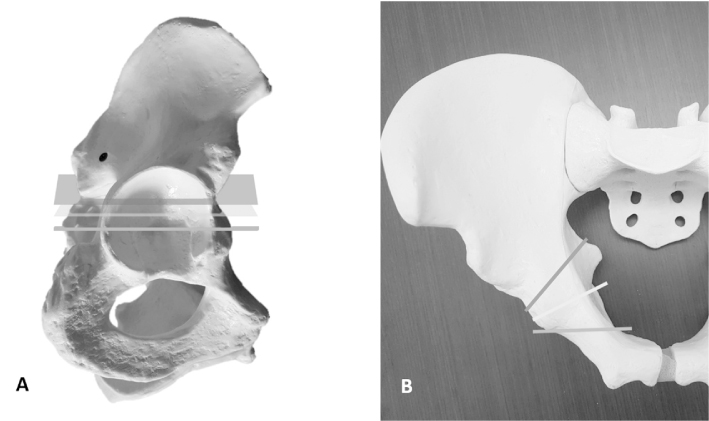

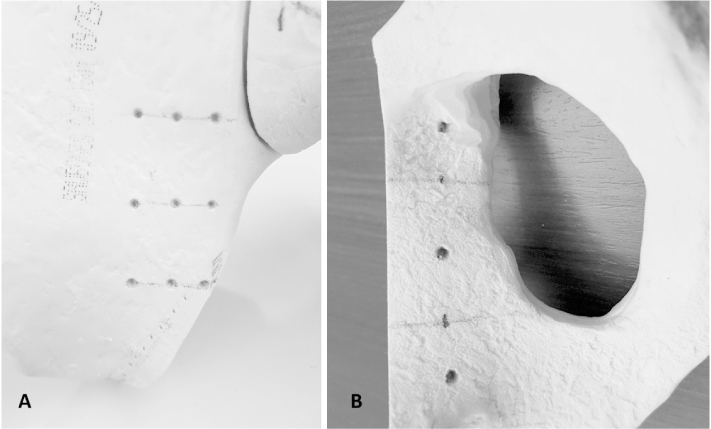
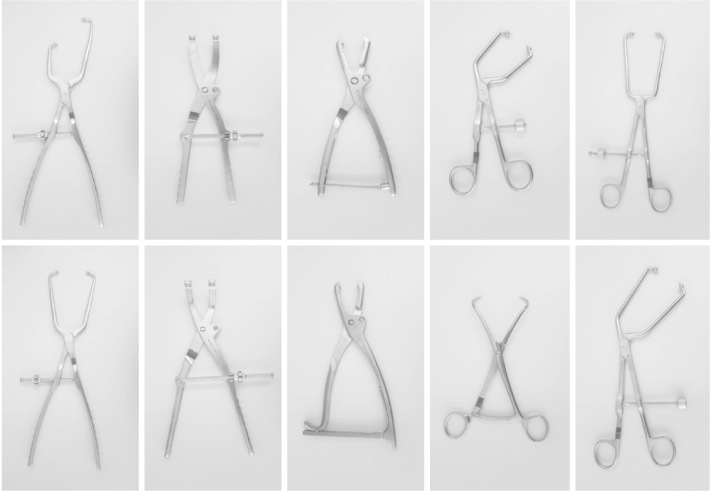
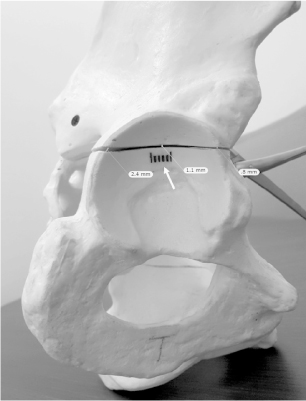
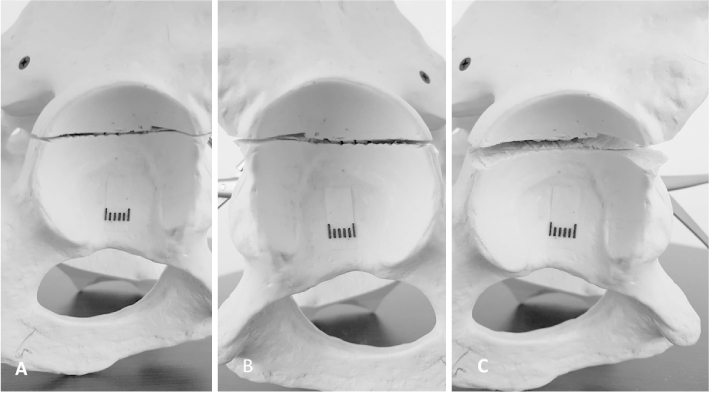
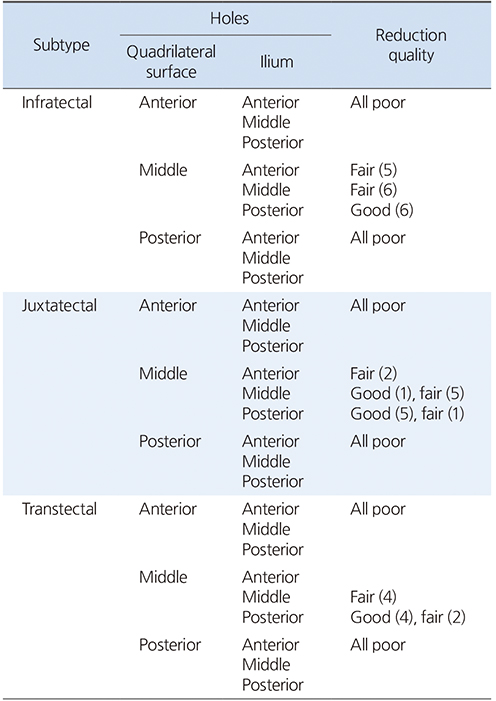
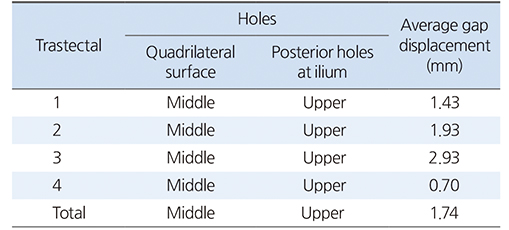

 PubReader
PubReader Cite
Cite

